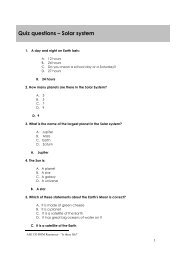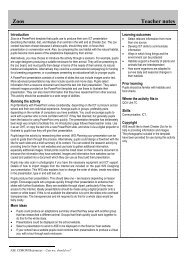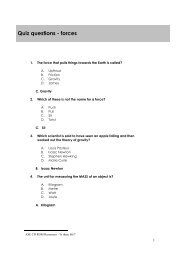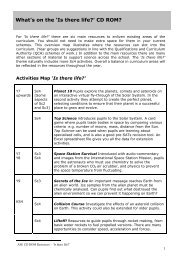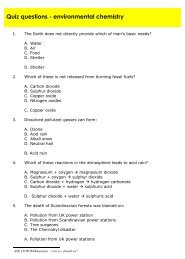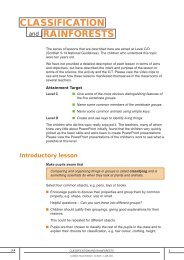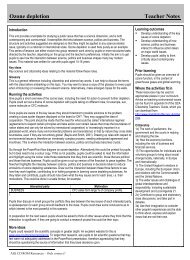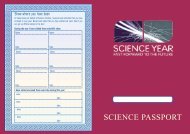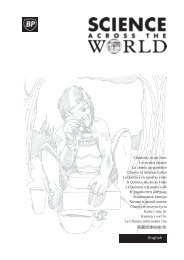Role-play in science teaching and learning - ASE Science Year CD ...
Role-play in science teaching and learning - ASE Science Year CD ...
Role-play in science teaching and learning - ASE Science Year CD ...
Create successful ePaper yourself
Turn your PDF publications into a flip-book with our unique Google optimized e-Paper software.
<strong>Role</strong>-<strong>play</strong> <strong>in</strong> <strong>science</strong> teach<strong>in</strong>g <strong>and</strong> learn<strong>in</strong>g<br />
McSharry <strong>and</strong> Jones<br />
Table 1 Categories of role-<strong>play</strong> with examples of exercises.<br />
Category of role-<strong>play</strong><br />
Experiments/<strong>in</strong>vestigations<br />
Games<br />
Presentations<br />
Metaphorical role-<strong>play</strong><br />
Analogy role-<strong>play</strong><br />
Simulation (or moral/ethical<br />
role-<strong>play</strong>)<br />
Theatre <strong>in</strong> education<br />
Example of role-<strong>play</strong> exercise<br />
Any practical experiment<br />
Cut-<strong>and</strong>-stick; card games; board games; dice games; memory game<br />
Child-<strong>in</strong>-role; make a radio or TV commentary; short or extended <strong>science</strong><br />
<strong>play</strong>s<br />
Human sculpture; mimes<br />
Us<strong>in</strong>g children as objects or elements of scientific theory<br />
Organised debates; simulated meet<strong>in</strong>gs; simulated court cases<br />
‘Outside’ drama companies which encourage audience participation<br />
Table 2 Some examples of the uses of games <strong>in</strong> the <strong>science</strong> curriculum.<br />
Examples of Suggested activity Examples of curriculum applications<br />
role-<strong>play</strong><br />
exercise<br />
Cut-<strong>and</strong>-stick Worksheets conta<strong>in</strong><strong>in</strong>g jumbled words, All aspects of the <strong>science</strong> curriculum, e.g.<br />
phrases or pictures which children cut out names of planets; bones <strong>and</strong> organs of the<br />
<strong>and</strong> stick <strong>in</strong> the correct order.<br />
body; Periodic Table; electrical symbols; etc.<br />
Card cycle Children work <strong>in</strong> groups to organise Cyclic aspects of <strong>science</strong>, e.g. water cycle;<br />
prepared <strong>in</strong>formation cards <strong>in</strong>to a loop. carbon cycle; nitrogen cycle; blood circulation;<br />
decay cycle; rock cycle; food webs.<br />
Match<strong>in</strong>g cards Prepared cards of words <strong>and</strong> pictures; Aspects of <strong>science</strong> that lend themselves to<br />
words <strong>and</strong> def<strong>in</strong>itions or word associations be<strong>in</strong>g matched, e.g. terms <strong>and</strong> def<strong>in</strong>itions;<br />
are arranged face-down on a table. Only type of radiation <strong>and</strong> its source; mach<strong>in</strong>es <strong>and</strong><br />
two cards can be picked-up at a time. The how they work; devices <strong>and</strong> energy changes;<br />
child keeps the match<strong>in</strong>g pair. The child organs <strong>and</strong> function; diagrams <strong>and</strong><br />
with most cards at the end w<strong>in</strong>s.<br />
descriptions of electrical circuits; sound <strong>and</strong><br />
source.<br />
20 questions Stick a word or picture label on children’s Elements, compounds <strong>and</strong> mixtures; the<br />
backs. Children can ask up to 20 Periodic Table; metals <strong>and</strong> non-metals; the<br />
questions to guess what is written on the skeleton; cells <strong>and</strong> their function;<br />
label. Answers are limited to yes or no. classification; energy resources; types of<br />
Children work <strong>in</strong> pairs.<br />
forces; chemical equations; electromagnetic<br />
spectrum; planets <strong>in</strong> the solar system.<br />
Board games Question <strong>and</strong> chance cards; trivial All aspects of the <strong>science</strong> curriculum, e.g.<br />
pursuits; ludo; snakes <strong>and</strong> ladders; growth <strong>and</strong> development; sex education;<br />
blockbusters; b<strong>in</strong>go.<br />
properties of chemicals; habitats; forces; etc.<br />
Dice game Children throw a dice to assemble a Skeletal system; organs of the body; parts of a<br />
scientific diagram which has had numbers flower; parts of the Periodic Table; electrical<br />
assigned to various parts of it.<br />
circuits.<br />
Memory game Ask pupils to remember everyth<strong>in</strong>g that Biology, chemistry <strong>and</strong> physics apparatus or<br />
was on a table or tray after look<strong>in</strong>g at it for terms; metals <strong>and</strong> non-metals; toy animals;<br />
one m<strong>in</strong>ute.<br />
various fuels.<br />
no experience of them <strong>in</strong> their lives. In these cases a<br />
good deal of background knowledge needs to be<br />
supplied, through textbooks or <strong>in</strong>formation sheets <strong>and</strong><br />
detailed ‘character cards’ that give <strong>in</strong>formation about<br />
any character’s op<strong>in</strong>ions <strong>and</strong> arguments. SATIS<br />
material is often excellent for this type of <strong>in</strong>formation<br />
(e.g. SATIS, 1987, 1988, 1991). The beauty of<br />
simulation is that it allows children to ‘practise’ with<br />
76 School <strong>Science</strong> Review, September 2000, 82(298)




